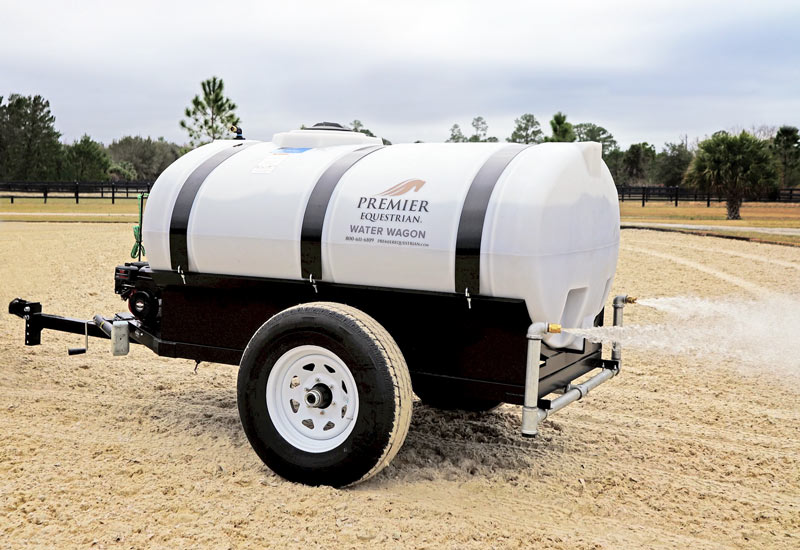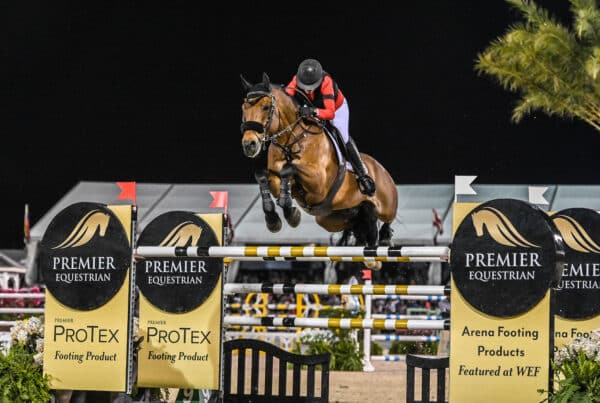Follow our tips to keep your riding arena in top form all year!
Thanks to the diversity of climate conditions across the US, there isn’t a one-size-fit- all protocol when it comes to arena maintenance. Variables such as the type of base your arena is built on and your maintenance equipment will also impact your management plan. But the good news is that with a little planning—and help from your friends at Premier Equestrian—your footing will be better prepped to weather the storm, no matter what Mother Nature has in store for you.

Premier Equestrian’s free Arena Sand Analysis will educate you about your arena sand and the best footing additives for it.
Do a Footing Health Check
At Premier Equestrian, we prefer using silica sand for arena footing whenever possible. Silica sand particles are hard and resist breakdown far better than more common types of sand, such as concrete sand, mason sand, or local quarry sand. The softer mineral compositions in these other sand varieties mean that over time they will break down and turn to dust. (Learn more about these types of sands and the proper footing solution.) Arenas made with non-silica sand typically need new material added more frequently than those made with silica sand.
If you don’t know what kind of sand is in your arena, take advantage of Premier Equestrian’s free Arena Sand Analysis. Our team of experts will put your sand under the microscope, literally, and we will create a personalized sand report to educate you about your type of sand and tell you when/if you should replace it or offer ways to help correct it.

Perhaps in the past you have added a footing product to your sand to improve cushioning, stability, and rebound. Premier Equestrian offers a full suite of high-quality products designed to suit your discipline, intensity of use, and budget—but none of these products are meant to last forever. Arenas will require a refresh of additive every 4 to 5 years, supplementing 10-20% of the original amount installed. As part of our free Arena Sand Analysis, we can also determine the health of your additive, and prescribe a refresh as needed.
Keeping your footing composition balanced—with just the right ratio of sand to additive—is key to keeping it at peak performance. Premier Equestrian President Heidi Zorn explains that creating the perfect footing is like baking a cake: “We use lab techniques to figure out what the sand is, and which additive mixed with sand and water will make the perfect cake,” says Zorn. “As the sand degrades and the footing product dissipates, all of a sudden, our cake gets runny, and the performance is way off from where we started.”
Just because you had an arena sand analysis done once, doesn’t mean you can’t have another one done now—in fact, routine analysis is the perfect way to ensure that your arena footing is in good health.

Assess your Arena Maintenance Tools
Whether you are looking to maintain an even mix of your arena components through a daily drag or are preparing for incoming weather (more on this later), you will need access to a high-quality arena drag suited to your footing type and tow vehicle.
The new Premier Equestrian SportPro Arena Drags offer our customers top-of-the-line, tow-behind arena groomers uniquely crafted to suit their specific arena moisture and additive needs. These sturdy, American-made drags hold up to frequent use, and the ground-engaging components are specially designed to break up, dig, mix, fluff, smooth, level, and compact horse arena footing. Each component to this drag is independently adjustable, meaning that several functions can be performed for footing maintenance, such as remixing the surface or adding new fibers. After a long winter when sand particles have separated, the drag will till the mix back together, giving you back your engineered surface performance, or easily set to a daily maintenance, giving you an ideal surface every day.

We can’t emphasize enough how important the correct groomer is to your arena health. Not only does routine dragging help maintain the optimal mix of additive to sand, it also can assist in moisture distribution—whether we are talking about naturally occurring precipitation, or the spray from Premier Equestrian’s 550 Gallon Water Wagon Trailer.
And while we’re on the topic, water management—either adding and retaining it in the dry season or diverting it in the wet—is one of the most critical aspects of effective arena management. In fact, Zorn says that having the right amount of water is the number one factor to maintaining good footing.

The Water Wagon Trailer is an ideal option to haul a large amount of water anywhere on your farm property, but it is still light and mobile enough to tow behind your compact tractor or truck. Unlike other common methods of adding water to your arena, such as misting systems and sprinklers, as much as 90% of the water distributed by the Water Wagon ends up just where it is supposed to—on your arena surface.
“Because the Water Wagon nozzles are close to the ground, the wind is not carrying the water away,” explains Zorn. “If you have a misting system, you will lose as much as 70% of the water, because a lot will evaporate before getting to the ground. For sprinkler systems, as a rule of thumb, you lose 40–50% in overspray, and it does not hydrate evenly.”
Water Wagons can be a major asset during the winter months in the southeastern U.S., especially Florida, and beginning with the spring months in the arid regions of California, Utah, Colorado, New Mexico, Nevada, and Arizona.

It’s All About the Base
Finally, the type of base installed beneath your arena footing will directly impact your year-round management strategies. There are two main base design categories—a compacted stone base and a free-draining base.

A compacted stone base is built with a slope or crown designed to encourage the water to run to an edge and drain away. Managing moisture on this type of arena typically requires effective dragging techniques. For example, before a snowy northeastern winter (when outdoor arenas are often left to freeze until warmer weather returns) or a rainy spring, compacting and rolling the arena is the perfect method to seal the surface and help divert excess water. But this same technique can be used in any region, any time a heavy rainfall is anticipated. After the storm, simply re-drag the ring with your groomer adjusted to remix and fluff the footing materials. This will encourage water movement out of your arena and air into the surface to help dry the footing.

Free-draining bases are the perfect solution for areas in need of intense moisture management—whether the issue is too much or too little water. There are several options for this type of installation, from a basic free-draining base (which incorporates a geotextile cloth to separate the base from the footing, encouraging better drainage) to OTTO Sport Arena Mats (the design of which helps to both drain and retain water within the footing as needed), and finally our gold-standard Arion Ebb and Flow Arena System.

“If you have a free-draining base and are expecting a storm, then you open up the footing so the water can pass through and drain,” explains Zorn. “It is the complete opposite strategy than if you have a compacted base.”
The Arion Ebb and Flow System offers the best of both worlds: retaining water through its system of underground pipes to hydrate dry footing from below, while also allowing excess water to drain away in times of heavier precipitation.

“If you live in a really rainy area, like some parts of the west coast or the eastern states, then a free-draining base, mat system, or Arion Ebb and Flow system will be the most effective way to maintain good footing year-round,” says Zorn.
A Few Final Thoughts
Maintaining the perfect training surface throughout the year comes down to having the right tools for the job, as well as playing to your arena’s strengths relative to your prevailing climate conditions.
“Your location, the climate, and the amount of precipitation you get per year will all affect the required maintenance,” summarizes Zorn. “In wetter areas, investing in a free-draining base, while in drier areas, adding some water saving options, will help your arena to perform at its best.”
We encourage new customers to get a free Arena Sand Analysis, which will give us the information needed to apply the appropriate footing product or maintenance protocol.
We also encourage existing customers to resubmit their sand every 4-5 years for analysis. We keep all the original sand reports, and with an updated analysis we can determine how well the sand and footing are holding up and what steps need to be taken to bring your arena back to a quality state.
The sand report from our Arena Sand Analysis will give you and in-depth look at the following:
-
- Type of sand
- Particle distribution
- Particle shape
- The best additives for your sand
- Maintenance tips to improve your surface
- Percent of degradation since your last report
About the author
Christina Keim is a professional equestrian and writer based at Cold Moon Farm in Rochester, NH. Over the course of her career, she has worked as a barn manager, head groom, riding instructor, and collegiate equestrian team coach. In 2015, she founded Cold Moon Farm with the mission to promote sustainable living, conservation, and the highest standards of compassionate horsemanship.





